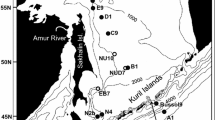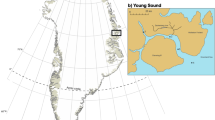Abstract
Population dynamics and production of the calanoid copepod Acartia omorii Bradford were studied from November 1986 to November 1987 in Fukuyama Harbor, a eutrophic inlet of the Inland Sea of Japan. This species was present in the plankton from October to July (temperature range: 8.9 to 24.3°C), with peaks in February-March and June. During this period, nine generations could be detected, for which the mean population egg production rate and midstage abundance of each life stage older than naupliar Stage (N) II were determined to trace survival. The population suffered extremely high mortality during the early life stages: on average only 2.5% of the eggs produced recruited into NII. This large loss is probably concentrated within the egg stage, due to predation, including cannibalism, by omnivorous copepods, in addition to sinking loss of eggs in the water column. However, the mortality from NII to copepodite Stage (C) V was negligible, indicating low predation pressure by large carnivores. The biomass of A. omorii showed marked seasonal variations in parallel with numerical abundance. The instantaneous growth rate of each stage increased exponentially with increasing temperature. The integrated production rate of A. omorii from 7 November 1986 to 21 July 1987 was 749 mg Cm-3 or 5.62 g Cm-2
Similar content being viewed by others
References
Bradford JM (1976) Partial revision of the Acartia subgenus Acartiura (Copepods: Calanoida: Acartiidae). NZ Jl mar Freshw Res 10:159–202
Christou ED, Verripoulos GC (1993) Analysis of the biological cycle of Acartia clausi (Copepoda) in a meso-oligotrophic coastal area of the eastern Mediterranean Sea using time-series analysis. Mar Biol 115:643–651
Durbin EG, Durbin AG, Smayda TJ, Verity PG (1983) Food limitation of production by adult Acartia tonsa in Narragansett Bay, Rhode Island. Limnol Oceanogr 28:1199–1213
Edmondson WT, Comita GW, Anderson GC (1962) Reproductive rate of copepods in nature and its relation to phytoplankton populations. Ecology 43:625–634
Fager EW (1973) Estimation of mortality coefficient from field samples of zooplankton. Limnol Oceanogr 18: 297–301
Hirota R (1964) Zooplankton investigations in Hiuchi-nada in the Setonaikai (Inland Sea of Japan). I. The seasonal occurrence of copepods at the three stations in Hiuchi-nada. J oceanogr Soc Japan 20:24–31
Hirota R (1979) Seasonal occurrence of zooplankton at a definite station off Mukaishima from July of 1976 to June 1977. Publs Amakusa mar biol Stn 5:9–17
Huntley ME, Lopez MDZ (1992) Temperature-dependent production of marine copepods: a global synthesis. Am Nat 140: 201–242
Kasahara S, Uye S, Onbé T (1974) Calanoid copepod eggs in sea-bottom muds. Mar Biol 26:167–171
Kasahara S, Uye S, Onbé T (1975) Calanoid copepod eggs in sea-bottom muds. II. Seasonal cycles of abundance in the populations of several species of copepods and their eggs in the Inland Sea of Japan. Mar Biol 31:25–29
Landry MR (1978) Population dynamics and production of a planktonic marine copepod, Acartia clausi, in a small temperate lagoon on San Juan Island, Washington. Int Rev ges Hydrobiol 63:77–120
Landry MR (1983) The development of marine calanoid copepods with comments on the isochronal rule. Limnol Oceanogr 28: 614–624
Liang D, Uye S, Onbé T (1994) Production and loss of eggs in the calanoid copepod Centropages abdominalis Sato in Fukuyama Harbor, the Inland Sea of Japan. Bull Plankton Soc Japan 41: 131–142
Liang D, Uye S, Onbé T (1996) Population dynamics and production of the planktonic copepods in a eutrophic inlet of the Inland Sea of Japan. I. Centropages abdominalis. Mar Biol 124:527–536
McLaren MR (1978) Generation lengths of some temperate marine copepods: estimation, prediction, and implications. J Fish Res Bd Can 35:1330–1342
Miller CB, Johnson JK, Heinle DR (1977) Growth rules in the marine copepod genus Acartia. Limnol Oceanogr 22:326–335
Peterson WT, Kimmerer WJ (1994) Processes controlling recruitment of the marine calanoid copepod Temora longicornis in Long Island Sound: egg production, egg mortality, and cohort survival rates. Limnol Oceanogr 39:1594–1605
Ueda H (1986a) Redescription of the planktonic calanoid Acartia hudsonica from Atlantic and Pacific waters: a new record from Japanese waters. J oceanogr Soc Japan 42: 124–133
Ueda H (1986b) Taxonomic reexamination and geographic distribution of copepods known as Acartia clausi in Japanese coastal and inlet waters. J oceanogr Soc Japan 42:134–138 (in Japanese with English abstract)
Ueda H (1987) Temporal and spatial distribution of the two closely related Acartia species A. omorii and A. hudsonica (Copepoda, Calanoida) in a small inlet water of Japan. Estuar cstl Shelf Sci 24:691–700
Uye S (1980a) Development of neritic copepods Acartia clausi and A. steueri. I. Some environmental factors affecting egg development and the nature of resting eggs. Bull Plankton Soc Japan 27:1–9
Uye S (1980b) Development of neritic copepods Acartia clausi and A. steueri. II. Isochronal larval development at various temperature. Bull Plankton Soc Japan 27:11–18
Uye S (1981) Fecundity studies of neritic calanoid copepods Acartia clausi Giesbrecht and A. steueri Smirnov: a simple empirical model of daily egg production. J exp mar Biol Ecol 50:255–271
Uye S (1982a) Population dynamics and production of Acartia clausi Giesbrecht (Copepoda: Calanoida) in inlet waters. J exp mar Biol Ecol 57:55–83
Uye S (1982b) Length-weight relationships on important zooplankton from the Inland Sea of Japan. J oceanogr Soc Japan 38:149–158
Uye S (1985) Resting egg production as a life history strategy of marine planktonic copepods. Bull mar Sci 37:440–449
Uye S, Yoshiya M, Ueda K, Kasahara S (1984) The effect of organic sea-bottom pollution on survivability of resting eggs of neritic calanoids. Crustaceana (Suppl) 7:390–403
Yamazi I (1956) Plankton investigations in inlet waters along the coast of Japan. XIX. Regional characteristics and classification of inlet waters based on the plankton communities. Publs Seto mar biol Lab 5:157–196
Author information
Authors and Affiliations
Additional information
Communicated by T. Ikeda, Hiroshima
Rights and permissions
About this article
Cite this article
Liang, D., Uye, S. Population dynamics and production of the planktonic copepods in a eutrophic inlet of the Inland Sea of Japan. II. Acartia omorii . Marine Biology 125, 109–117 (1996). https://doi.org/10.1007/BF00350765
Received:
Accepted:
Issue Date:
DOI: https://doi.org/10.1007/BF00350765




